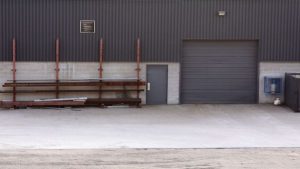Selecting the right warehouse racking is essential to the operations of your warehouse. Many warehouses waste space by using the wrong type of rack for their inventory. In the current market, warehouse space is worth more than ever, and should be optimized as much as possible.
Your racking should provide you with the highest density of storage possible, for the smallest footprint.
1. Mobile pallet rack
This pallet racking system provides some of the highest density storage possible. The racks are placed along a set of rails and stacked directly next to one another. They are then moved apart mechanically, allowing access to the space between two of the units.
You can open an aisle between racks then move the racks along to create the aisle space between different racks. For warehouses struggling to manage in their space, this allows you to set up multiple racks with space for just one aisle.
2. Pallet flow racks
Pallet flow racks use gravity to roll pallets forward on a tilted rack. They are loaded from one end and picked from another. Each time a pallet is removed, a series of wheels and brakes rolls another into its place.
The pallets only need to be accessed at each end of the flow, instead of multiple points along a shelf. This means the space required for access is greatly reduced. You can save up to 60 percent of your warehouse space by using this system.
3. Carton flow racks

These racks operate in the same manner as pallet flow racks, but they are designed for cartons. This allows you to achieve maximum density for smaller items stored within the warehouse. It also allows faster flow than more static industrial shelving.
Another benefit of flow racks is that they allow you to take advantage of vertical space. This is useful if you have reached horizontal storage capacity and cannot expand.
4. Push back racks
Push back racking means you store pallets directly behind one another, pushing them back as more pallets are added. They are lined up with only one pallet accessible to the aisle. This means the aisle space is reduced, allowing more density of storage per square foot of warehouse space.
The result is a First In, Last Out (FILO) system, suitable for inventory that can remain in a warehouse for extending periods of time.
5. Cantilever racks
These open-sided racks allow you to store items of any length. You can add decking to the cantilever arms, for the support of more irregular items. Cantilever racks are particularly suitable for large items such as furniture, which may be damaged if moved on and off a normal pallet racking system.
Furniture, and other large cumbersome items, may otherwise take up significant areas of your warehouse. By utilizing a cantilever rack, you can store these items vertically, drastically reducing the footprint required.
6. Drive in/drive thru racks
These racks allow space for a forklift to drive into the rack bay. Drive in racks have one access point, while drive thru racks have an entry and exit. The pallets are loaded into deep racks and accessed only at one point.
For either option, the space required to reach the pallets is reduced, increasing storage density. This is ideal for a warehouse that uses mainly forklifts, as the aisle width requirements can take up a lot of floor space.
7. Drum pallet racks
Drums of liquid can be difficult to store, particularly if they contain hazardous materials. Many warehouses might store them on the ground level only. This may also mean you store them standing upright, to reduce the risk of falls and spills.
Drum pallets have rounded cradles, allowing you to store the drums horizontally without any chance of them rolling or falling. These can then be placed into a drum pallet rack, which can stack multiple pallets. This allows you to store drums in a vertical space, with minimal risk of spilling.



